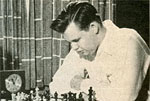Hugh Myers (1930-2008)
With the death of Hugh Edward Myers (Davenport, IA, USA) the chess world has
lost a writer and theoretician most noted for specializing in ‘unusual’
openings. From November 1979 to December 1996 he intermittently edited and published
The Myers Openings Bulletin, offering a remarkable diet of deeply-researched
openings articles (no opening seemed too abstruse for consideration), historical
features, book reviews and topical commentary. He included contributions from
many writers who later gained prominence in their own right, and the Bulletin
built up a loyal, affectionate readership throughout the world.

Myers made a particular study of the Nimzowitsch Defence (1 e4 Nc6) and wrote
several monographs on it, the last one being in 1995 (published by Caissa Editions).
Earlier books were New Strategy in the Chess Openings (1968), Reversed
King Pawns: Mengarini’s Opening (1977) and Exploring the Chess
Openings (1978). In 2002 he brought out his 239-page autobiography, A
Chess Explorer. It included 130 of his games, intermingled with reminiscences,
at turns comic and tragic, of his adventures and encounters. For instance, he
was acquainted with Bobby Fischer and wrote on pages 42-43:
‘He won the US Championship for the first time on 7 January 1958, clinching
it with a short last-round draw against Abe Turner. It was a snowy evening.
I was one of the few people he would listen to (Probably because he respected
my taste in openings! I don’t think he knew anyone else who owned and
loved a 1956 Russian openings book by Lipnitsky, as we both did). So I was
the only person to escort Fischer and his mother to the subway station. He
was celebrating by throwing snowballs at passing buses! I got him to stop
that, telling him he wouldn’t want to see his name in the morning papers
both for winning the championship and for getting arrested.’

Among Myers’ admirable traits were independence of mind and forthrightness,
and those qualities were much in evidence in 1985 when, almost alone in the
chess world, he disputed the (then) commonly accepted version of the rights
and wrongs regarding the termination of the 1984-85 world championship match
between Karpov and Kasparov. This eventually led to his becoming acquainted
with Florencio Campomanes and, as related on pages 184-194 of A Chess Explorer,
he worked to ensure the Filipino’s re-election as FIDE President in 1986.
Myers was a fine, incisive writer, and never were his wit and fire deployed to greater
effect.
Dogged by illness and other personal difficulties, Myers played competitive
chess increasingly seldom, concentrating on writing whenever his health and other
circumstances permitted. The four games below are taken from his last book,
A Chess Explorer. The first of them became quite well known, having been
annotated by Hans Kmoch on page 89 of the March 1957 Chess Review:
Hugh Edward Myers – William Lombardy
Semi-final, Manhattan Chess Club Championship, New York, 1957
Réti Opening
1 g3 Nf6 2 Bg2 d5 3 Nf3 Bf5 4 c4 c6 5 cxd5 cxd5 6 Qb3 Bc8 7 O-O e6 8 Nc3 Nc6
9 d4 Bd6 10 Rd1 h6 11 a3 Na5 12 Qc2 Bd7 13 b4 Nc4 14 e4 dxe4 15 Nxe4 Rc8 16
Ne5 Bxe5 17 dxe5 Nd5 18 Qe2 O-O 19 Qh5 Qc7 20 Rxd5 exd5 21 Nf6+ gxf6 22 exf6
Nd6 23 Bxh6 Bf5 24 Bxd5 Qc2 25 Bxf8 Rxf8 26 Qh6 Ne8 27 Re1 Bg6 28 Rxe8 Qd1+
29 Kg2 Qxd5+ 30 f3 Qd2+ 31 Qxd2 Rxe8 32 Qh6 Resigns. [Click
to replay]

Extract from the annotations to Myers v Lombardy, by Hans Kmoch,
Chess Review, March 1957, page 89
Next, a friendly contest in which Myers gave up six pawns in the first ten
moves (‘I was drinking rum before and during the game’):
Hugh Edward Myers – Tirso Alvarez
Santo Domingo, 24 December 1966
Amar Opening/Paris Opening
1 Nh3 d5 2 g3 e5 3 f4 Bxh3 4 Bxh3 exf4 5 O-O fxg3 6 e4 gxh2+ 7 Kh1 dxe4
8 Nc3 Nf6 9 d3 exd3 10 Bg5 dxc2
11 Qf3 Be7 12 Qxb7 Nbd7 13 Bxd7+ Nxd7 14 Bxe7 Kxe7 15 Nd5+ Kf8 16 Nxc7 Nc5
17 Ne6+ Nxe6 18 Qxf7 mate. [Click
to replay]
‘This is one of the best of all my games’, wrote Myers of his next
brilliancy, which was also annotated by Kmoch (Chess Life & Review,
October 1970, pages 564-565):
Hugh Edward Myers – Juan Leon
Championship of San Juan, Puerto Rico, 1969
Sicilian Defence
1 e4 c5 2 Nf3 g6 3 h4 Bg7 4 h5 d6 5 Bb5+ Bd7 6 a4 gxh5 7 Rxh5 a6 8 Bxd7+
Qxd7 9 d3 Nf6 10 Rh4 Nc6 11 Nc3 O–O-O12 a5 d5 13 Na4 Kb8 14 Bf4+ Ka7 15
Nxc5 Qe8 16 Bc7 Rc8 17 Bb6+ Ka8 18 Qe2 dxe4 19 dxe4 Nd7
20 Nxa6 bxa6 21 Qxa6+ Kb8 22 e5 Rc7 23 Bxc7+ Kxc7 24 e6 fxe6 25 Ng5 Qg6 26
Rc4 Ndb8 27 Qb6+ Kd7 28 Rd1+ Ke8
29 Qxb8+ Resigns. [Click to
replay]
The noted authority Ariel Mengarini praised the final game:
Hugh Edward Myers – B. Devin
US Open, Chicago, 1973
Sokolsky Opening
1 b4 c6 2 Bb2 Qb6 3 a3 a5 4 c4 axb4 5 c5 Qc7 6 axb4 Rxa1 7 Bxa1 d5 8 Nf3
f6 9 e3 e5 10 Be2 b6 11 O-O bxc5 12 bxc5 Bxc5 13 d4 Bd6 14 e4 Ne7 15 Nc3 exd4
16 Qxd4 c5 17 Qa4+ Bd7 18 Nb5 Bxb5 19 Bxb5+ Kf8 20 exd5 Nxd5 21 Re1 Be7 22 Qe4
Nf4
23 Ng5 g6 24 Qxf4 Resigns. [Click
to replay]

From Chess Review, February 1954, page 36
Hugh Myers was a true chess lover, and a lover of chess truth.
Stefan Bücker, the Editor of Kaissiber,
adds:
Hugh Myers’ inventiveness springs from almost every page of his 1978
book Exploring the Chess Openings. Today, the King’s Indian Attack
has become a standard opening, but Myers had begun studying and playing 1
g3 and related systems such as 1 e4 c5 2 g3 and 1 e4 e6 2 d3 in the late 1940s.
Subsequently he explored 1 Nf3 d5 2 a4 Nf6 3 b4 and 1 e4 c5 2 a4. Regarding
the latter, he wrote in A Chess Explorer (page 115): ‘My name,
in books and magazines, has been attached to several openings. In my mind,
there’s no better case for it than here, because of playing priority
and writing an explanation of its theory ...’

Regularly he used black set-ups with the white pieces, adding a harmless-looking
extra move, as in the case of 2 a4 mentioned above, or, after 1 e4 e5 2 Nc3
Nf6, another extra move, 3 a3!?, on which he wrote a 44-page booklet (Reversed
King Pawns: Mengarini’s Opening). The hidden points of these ideas
often escaped his opponents’ attention. He is perhaps best known for
his pair of defences called Myers’ Defence: 1 g3 g5 and 1 c4 g5. These
ideas later influenced Michael Basman to risk the ...g5 and ...h6/...g5 systems
even against 1 e4 and 1 d4. Myers’ in-depth work on 1 e4 Nc6 is required
reading for anyone who plays that defence.
There have been other opening artists, most of them lone warriors. Hugh Myers
was an erudite and careful author, and he liked to share his ideas with others.
The Myers Openings Bulletin became the focus of discussions about all
kinds of openings, often unorthodox. Having sent games to other magazines
without receiving a reply, I found it extremely encouraging to come into contact,
thanks to Gerard Welling, with Myers and his Bulletin. To correspond
with him was a pleasure, since he never rejected any idea, however unusual,
without first checking it carefully.
External link: Autobiographical information provided by Hugh Myers to Edward Winter: Chess Notes (C.N. 5909)
































